- Region
- Águilas
- Alhama de Murcia
- Jumilla
- Lorca
- Los Alcázares
- Mazarrón
- San Javier
-
ALL AREAS & TOWNS
- AREAS
- SOUTH WEST
- MAR MENOR
- MURCIA CITY & CENTRAL
- NORTH & NORTH WEST
- TOWNS
- Abanilla
- Abarán
- Aguilas
- Alamillo
- Alcantarilla
- Aledo
- Alhama de Murcia
- Archena
- Balsicas
- Blanca
- Bolnuevo
- Bullas
- Cañadas del Romero
- Cabo de Palos
- Calasparra
- Camping Bolnuevo
- Campo De Ricote
- Camposol
- Canada De La Lena
- Caravaca de la Cruz
- Cartagena
- Cehegin
- Ceuti
- Cieza
- Condado de Alhama
- Corvera
- Costa Cálida
- Cuevas De Almanzora
- Cuevas de Reyllo
- El Carmoli
- El Mojon
- El Molino (Puerto Lumbreras)
- El Pareton / Cantareros
- El Raso
- El Valle Golf Resort
- Fortuna
- Fuente Alamo
- Hacienda del Alamo Golf Resort
- Hacienda Riquelme Golf Resort
- Isla Plana
- Islas Menores & Mar de Cristal
- Jumilla
- La Azohia
- La Charca
- La Manga Club
- La Manga del Mar Menor
- La Pinilla
- La Puebla
- La Torre
- La Torre Golf Resort
- La Unión
- Las Palas
- Las Ramblas
- Las Ramblas Golf
- Las Torres de Cotillas
- Leiva
- Librilla
- Lo Pagan
- Lo Santiago
- Lorca
- Lorquí
- Los Alcázares
- Los Balcones
- Los Belones
- Los Canovas
- Los Nietos
- Los Perez (Tallante)
- Los Urrutias
- Los Ventorrillos
- Mar De Cristal
- Mar Menor
- Mar Menor Golf Resort
- Mazarrón
- Mazarrón Country Club
- Molina de Segura
- Moratalla
- Mula
- Murcia City
- Murcia Property
- Pareton
- Peraleja Golf Resort
- Perin
- Pilar de la Horadada
- Pinar de Campoverde
- Pinoso
- Playa Honda
- Playa Honda / Playa Paraíso
- Pliego
- Portmán
- Pozo Estrecho
- Puerto de Mazarrón
- Puerto Lumbreras
- Puntas De Calnegre
- Region of Murcia
- Ricote
- Roda Golf Resort
- Roldan
- Roldan and Lo Ferro
- San Javier
- San Pedro del Pinatar
- Santiago de la Ribera
- Sierra Espuña
- Sucina
- Tallante
- Terrazas de la Torre Golf Resort
- Torre Pacheco
- Totana
- What's On Weekly Bulletin
- Yecla


- EDITIONS:
 Spanish News Today
Spanish News Today
 Alicante Today
Alicante Today
 Andalucia Today
Andalucia Today
The Casa Pintada in Mula
The Casa Pintada and Fundación Cristóbal Gabarrón Mula
The Casa Pintada in Mula is an essential stop-off point for anyone enjoying a street tour of the historic old quarter of Mula, being not only an attractive and emblematic building in its own right but also the home of a contemporary art foundation dedicated to Mulas most important contemporary artist, Cristóbal Gabarrón.
History of the Casa Pintada
During the 18th century the economy of Mula enjoyed a certain revival after the plagues, famines and illnesses which had continued to decimate the population during the 16th and 17th centuries in the past, good agricultural conditions and fertile soils providing the opportunity for several noble families to amass great fortunes. In the mid 18th century the nobility embarked on a building spree, constructing significant homes and palaces for themselves, to reflect their status and wealth.
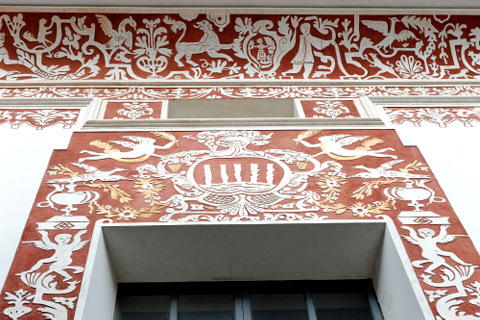 The construction of the homes of the nobility focused in two distinct areas: Calles San Francisco, Caño, Coy (now Valmarino) . Bótocas, San Miguel and around Plaza Mayor, the other being around Palacio (nowadays Martín Perea) Marqués and Don Pedro Luís.
The construction of the homes of the nobility focused in two distinct areas: Calles San Francisco, Caño, Coy (now Valmarino) . Bótocas, San Miguel and around Plaza Mayor, the other being around Palacio (nowadays Martín Perea) Marqués and Don Pedro Luís.
This building boom was fuelled by the construction of churches and public buildings at the same time and many of the emblematic palaces and churches in Mula all date from this same period of 1740 to 1780.
Raw materials were plentiful, with marble coming from the quarries in Cehegín nearby and a factory in the area close to the River Pliego river (Vado de la Tejera) which made tiles and bricks, as well as wood from the forests of the north-west.
The Blayas
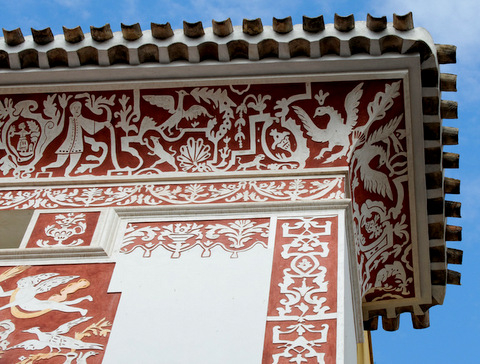 The noble family who built the Casa Pintada are believed to have been of French origin and arrived in Mula in 1490, moving from Hellín in the province of Albacete.
The noble family who built the Casa Pintada are believed to have been of French origin and arrived in Mula in 1490, moving from Hellín in the province of Albacete.
Don Gonzalo de Blaya y Valcárcel carried documentation stating that his own ancestry lay with a mythical figure, Don Roldán, Count of Blaya, nephew of the great Charlemagne, who came to Spain to fight in the Reconquista of Spain, when the Christian forces of Aragón and Castile fought to gain lands occupied by the Moors (including what is now the Region of Murcia, which was under Moorish rule from 713 to 1243).
Don Gonzalo married Doña María Jiménez de Palomeque Padilla and during the two subsequent centuries his descendants made a number of advantageous marriages within the local nobility, linking them strongly to the most powerful and wealthy local family, the Melgarejos, who could trace their own roots back to the Reconquista in 1243. In that year one of their ancestors arrived as a knight supporting the King of Castile in his bid to recapture southern Spain.
The wealth and lands accumulated through these marriages helped to make the family the second wealthiest in the area, second only to the Valcárcel family, giving them control over water rights and power to control the local council. This in turn ensured that family members could obtain valuable concessions and manipulate the law to ensure their relatives continued to gain even more influence in the area.
The man who built the Casa Pintada was Don Diego de Blaya y Molina, the only surviving son of Don Gonzalo de Blaya Piñero and his wife Doña Mariana de Molina Valcárcel, and he himself married Doña Ginesa Álvarez Fajardo, from Cehegín, a bride with a huge dowry, cementing a marriage with a wealthy and well connected family.
 The house was built in Calle San Francisco, a street favoured by the wealthy nobility, and was most likely the work of one of the two major architects and builders working in Mula at the time, Lorenzo Duarte andr Rodrigo Lentisco.
The house was built in Calle San Francisco, a street favoured by the wealthy nobility, and was most likely the work of one of the two major architects and builders working in Mula at the time, Lorenzo Duarte andr Rodrigo Lentisco.
The family would have occupied the first floor while the ground floor was filled with kitchens, and servants' quarters and linked to the stables. There were storage rooms for grain and food on the upper floor and attics, which would have been filled with grain from the estates, hams and sausages from the annual matanza and straw for the horses, fed down via chutes and pulleys.
The house was occupied for the 18th century and early part of the 19th century, but during the latter part of the 19th century there is no mention of any occupation. By the 20th century it was no longer in use as a residential dwelling and next appears in records in 1926 when part of it was opened as a school. Another part of the building became the residential dwelling of a family from Bullas, who opened a rag and second hand kitchenware shop and kept them open for 40 years.
At the end of the Civil War the Auxilio Social, an organisation run by the Franco regime and dedicated to providing aid for those suffering from extreme poverty, opened its doors in the building and in 1969 it became the home of the Salonac club, a location where young people could meet and enjoy social activities. It also became a state-owned school and was used as a gas bottle distribution centre.
However, the condition of the building continued to deteriorate and in 1978 a project was presented to the Association of Architects in Murcia to demolish it and construct an apartment block in its place. This project was rejected due to the historical value of the property, but shortly after the rejection the house was mysteriously set on fire: although no criminal charges were ever pressed, it was widely reported that the arson had been instigated by its owner, who wanted it out of the way.
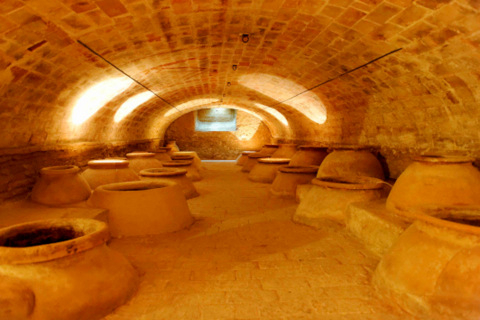
The fire caused severe damage to the roof and structure and the owner was ordered a bulldozer to go in and demolish the building in the early hours of 9th June 1981, but rapid intervention by the neighbours prevented its total destruction. Nonetheless, a quarter of the fachada was lost, along with the balcony displaying the coast of arms of the Valcárcel family and a great deal of the stencilled façade.
Those who were fighting to conserve the building were furious and demanded reprisals and criminal charges against the owner, a descendant of the noble family who built it, but the whole matter was hushed up never resulted in a prosecution.
In 1982 the building was declared as being of cultural interest and in 1986 the regional government department of Política Territorial managed to buy two thirds of the property with the aim of converting it into dwellings. In 1990 a heavy spring storm caused a large chunk of the cornice to fall down, after which steps were finally taken to conserve the building.
The community created a plan to build 6 residential properties in the rear of the house,and restore the façade, creating a space for public use. Architect José María Hervás undertook the project and rebuilt the property, restoring much of the façade to its original splendour and employing the distinctive sgraffito designs so typical of the baroque palaces of the period.
In 2004 an agreement was signed with the Fundación Cristóbal Gabarrón to open the house as an art museum, dedicated to the works of the local artist.
Façade
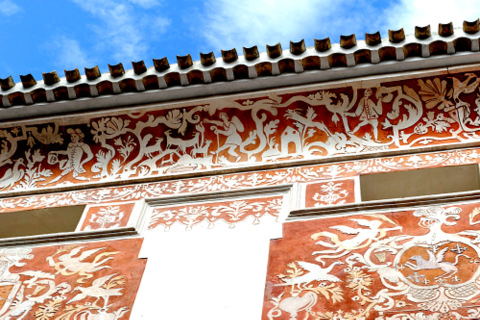 The most striking feature of the house is its exterior decoration, a red and white riot of images and design which fill the front of the house with life and movement using the sgraffito technique. This style of decoration is created by creating a lower level of colour, which is then revealed by applying a top layer of a different colour and scratching out the top layer in the desired pattern. In this case the scale of the decoration is referred to as "horror vacui", a horror of empty space, meaning that every inch possible is decorated.
The most striking feature of the house is its exterior decoration, a red and white riot of images and design which fill the front of the house with life and movement using the sgraffito technique. This style of decoration is created by creating a lower level of colour, which is then revealed by applying a top layer of a different colour and scratching out the top layer in the desired pattern. In this case the scale of the decoration is referred to as "horror vacui", a horror of empty space, meaning that every inch possible is decorated.
The themes of the representations are strictly profane (ie without any reference to a religious theme), the only exception being the odd angels which appear in various places within the coats of arms, symbolizing the divine protection of the lineage.
On the ground floor, the exterior features baroque marble quarried nearby in Cehegín, and a mural sgraffito decoration only appearing between two windows. These decorations feature hunting scenes, a popular motif at the time in ceramics, paintings, prints and residential décor, hunting being the province of the gentry.
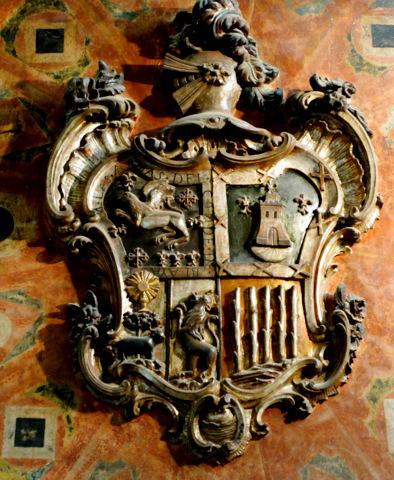 The decoration on the first floor focuses on the glorification of the house of Don Diego María, featuring each of the four crests of the families whose name he bears: Blaya, Molina, Piñero and Valcárcel. These support a number of scenes with figures and garlands, lions, birds, vases of flowers, flowers entwined with winged serpents, etc.
The decoration on the first floor focuses on the glorification of the house of Don Diego María, featuring each of the four crests of the families whose name he bears: Blaya, Molina, Piñero and Valcárcel. These support a number of scenes with figures and garlands, lions, birds, vases of flowers, flowers entwined with winged serpents, etc.
This is all supported by the plaster mouldings which separate the panels and the cornice, a riot of popular scenes, with animals, birds, flowers, floral motifs, knights, dogs , vases, eagle headed figures etc.
Inside the house, other interesting features are the cellar, which still contains all the original storage jars used to hold oils, wines and grain in domestic dwellings of this nature, and the impressive coat of arms dominating the entrance to the first floor.
Fundación Cristóbal Gabarrón
Cristóbal Gabarrón is Mula's best known contemporary artist and has produced works in a vast range of mediums. As a sculptor, painter, muralist and engraver and has been described as "one of the most representative artists of the latter generations of Spanish artists."
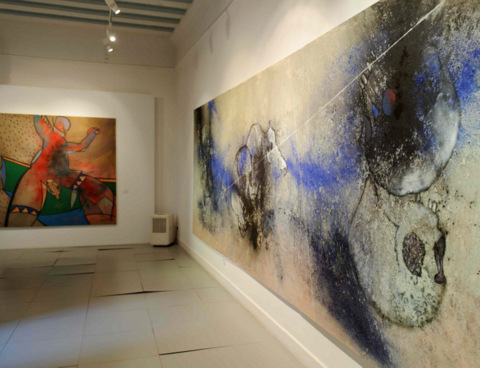 This building holds a number of his paintings and sculptures, showing a broad representation of the works he has produced the prestige of this internationally recognised artist. Click for more information about the collection and Fundación Cristóbal Gabarrón, or about Cristóbal Gabarrón the artist.
This building holds a number of his paintings and sculptures, showing a broad representation of the works he has produced the prestige of this internationally recognised artist. Click for more information about the collection and Fundación Cristóbal Gabarrón, or about Cristóbal Gabarrón the artist.
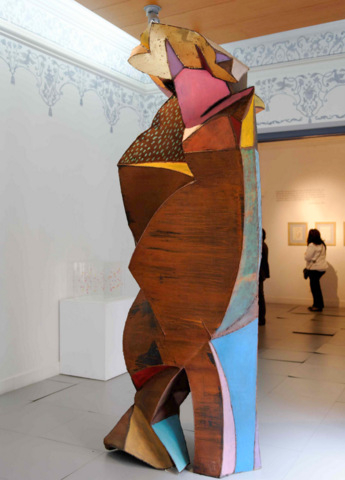 The exhibition is open to the public:
The exhibition is open to the public:
Tuesday to Saturday 10.30am to 2pm and 5.30pm to 8pm
Sundays and public holidays 11am to 2pm
Address:
Calle San Francisco, 14
30170 Mula
There is no parking immediately next to the building but this is just a short walk from the Glorieta Juan Carlos I and the Convento de San Francisco.
Click for map, Calle san Francisco, Mula
Telephone: 968 66 27 62
Entry is free, although there are boxes for visitors to make a donation towards maintenance.

